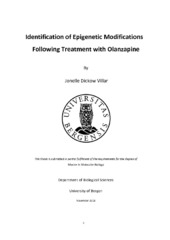Identification of Epigenetic Modifications Following Treatment with Olanzapine
Master thesis
Permanent lenke
http://hdl.handle.net/1956/18849Utgivelsesdato
2018-12-19Metadata
Vis full innførselSamlinger
Sammendrag
No chronic disease burdens the world more than psychiatric disorders (Collins et al., 2011), with an estimated 40% of the population in 30 European countries affected in any given year (Insel et al., 2012). Current medical treatment for schizophrenia (SCZ), bipolar disorder (BPD) and major depressive disorder (MDD) is based upon well-established antipsychotic drugs and mood stabilizers. Treatment efficacy (30-40%) (P. Lowe et al., 2017) and potentially serious side effects (Leucht et al., 2013) often challenge medication compliance, adding an additional challenge in the path towards wellness. New drugs are required to address the burden of psychotic disorders, and yet a new science is required to address the interplay between the heterogeneous nature of psychotic disorders and drug mechanisms. Epigenetic mechanisms, particularly alterations of methylation patterns at CpG sites have been shown to alter gene expression in humans, animal models and in vitro cell cultures. It is believed that epigenetic modifications induced by antipsychotic drugs plays a role in therapeutic response. Identification of pathways implicated by epigenetically modified genes, including the dopaminergic pathway, for example, has enhanced our understanding of the therapeutic mechanism of the antipsychotic drug olanzapine (Melka et al., 2013). In the current study, we aimed to identify differentially methylated regions induced by olanzapine. 82 European patients adhering to monotherapy were selected through the TOP Cohort (Thematically Organised Psychosis). Methylation data derived from blood samples was assessed genome-wide using the Illumina 850K EPIC array. The statistical model was corrected for gender and smoking. Following identification of differentially methylated positions (DMPs) in patient blood, we exposed a cultured cell line (HepG2) to verify the modifying effect of olanzapine on DNA methylation levels. The results of our study provide evidence of differentially methylated positions and regions in the blood of patients adhering to olanzapine monotherapy. A comparison of models adjusting for cell type composition provided evidence of improved p-values when cell type adjustment was included in the model. This finding was in concordance with state-of-the-art epigenome-wide-association (EWA) studies. Our results showed concordance between blood and brain for two identified differentially methylated regions, including the Trio and F-actin binding protein (TRIOBP) shown to be relevant in schizophrenia (Nicholas J. Bradshaw et al., 2014). The pathways implicated by the differentially methylated genes showed evidence of alterations in immune pathways and the possible mediating effect of olanzapine.
